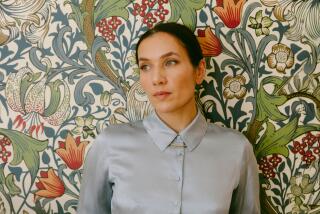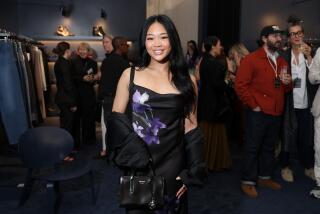Wardrobe Economics : Students: Working collegians forsake campus trends for suits, shoes and separates that fit the corporate image.
- Share via
Yes, Virginia, there is more to college clothing than jeans, sweats, T-shirts and shorts. There are conservative suits and ties, practical blazers, demure skirts, sensible shoes and control-top panty hose.
Southern California’s gainfully employed students know all about such matters. And surprise! They don’t mind covering their tan legs, buttoning up their dress shirts or temporarily forsaking their miniskirts to conquer the “real” world in style.
As they head back to school this fall, working collegians have special priorities. In addition to spiffy shorts and athletic shoes, they want corporate-caliber garments that say they mean business on the job--anywhere from accounting firms to Warner Bros.
Despite spiraling education costs (school fees alone have reached $1,602 a year at UCLA, $780 at the California state universities) and hefty personal expenses, these students manage to dress for success by skimping on their campus wardrobes.
Typical of his generation, Brian Daly, 21, a junior at Cal Poly Pomona and a part-time Sears salesman, follows the rules of power dressing. His executive-level wardrobe, which comes primarily from Nordstrom, includes a blue pin-stripe suit.
Along with studying for a degree in finance, real estate and law, Daly sells audio-visual equipment 20 to 25 hours a week, strictly on commission. When customers come looking for him, they ask for “that clean-cut, well-dressed man.”
“I take pride in dressing well,” he says, even though that means making sacrifices. If it weren’t for his job, he might invest in “a more contemporary suit” to wear out to dinner. But in all likelihood, Daly’s next major purchase will be new shoes for work.
Stacy Brown, a 22-year-old student at Santa Monica College, struggles with similar choices. She attends classes six hours a week and works full time as an office assistant in a large West Los Angeles corporation. “I used to buy real trendy clothes,” Brown recalls. “But when you only have a certain amount of money, you learn to buy more versatile things, like skirts and blazers, because you can mix and match them. I would love to buy something just for school or socializing. But I feel guilty. I feel I should buy work clothes. I want to move up in this company.”
In a rare slip, Brown once wore lace-trimmed leggings on the job and was told they were unacceptable. Since then, she has been careful: “My boss made it very clear to me how we are expected to dress. I don’t want to be told again. It’s not professional.”
Far from feeling oppressed, Brown says, “I really like the things I buy for work.” She shops Bullock’s and Nordstrom, trying not to exceed $60 for a jacket or $40 for a skirt. She pulls together a week’s wardrobe from her assortment of seven or eight solid-colored skirts (most of them one inch above the knee but a few ankle-length) and an equal number of jackets, including solids, a houndstooth check and a black-and-fuchsia mix.
But some career-minded students can’t resist them. During a recent shopping trip, Lorenda Johnson, who attends Cal State Dominguez Hills and works as receptionist for a freight company, picked out a pretty one-piece floral. And Angela Rose, who combines graduate studies at Biola University with a part-time job at St. John’s Child Study Center, buys dresses that are “very classy, but not stuffy.”
Rose’s job has its wardrobe hurdles: “I work with the children on the playground, and I meet with their parents,” she explains. “I have to be casual for the kids and more professional for the parents.” She relies on “good-quality, comfortable clothes,” such as T-shirts, ankle-length skirts, pants and walking shorts, to which she can add a jacket or, very often, a cardigan.
Although Damon Fisher, a junior majoring in finance at Cal State Northridge, would like to wear only T-shirts and shorts on campus, he has to be more flexible. On days when he goes directly from school to work in a financial planner’s office, he wears a suit and tie or a dress shirt and slacks. His taste level “is not too conservative and not too flashy,” and it was acquired, he wryly comments, “from watching my dad tie his ties in the morning.”
Those ties must have been outstanding, because Fisher’s wardrobe, from stores such as Robinson’s, Fred Segal and Ixiz, includes $100 slacks and a $500 Ralph Lauren suit. Happy in his upscale job (he was once a waiter), Fisher is philosophical about the money he spends to look professional: “Working in the business world requires a good appearance until you reach a certain level. Then it doesn’t matter what you wear. For now I have to go with the flow.”
To go with the flow this fall, working collegians might try a few suggestions from retailers. The Bullock’s list for women includes classic white shirts, coat dresses, short, full “cheerleader” skirts and long shapely jackets with stretch fabric added for a snugger, smoother fit.
The Robinson’s recommendation for women is an oversized “boyfriend” jacket in washed silk. Or, for those who prefer a real old fling, there are authentic secondhand men’s jackets in the junior department.
For men, the Robinson’s list includes double-breasted suit jackets and floral ties. But if floral neckwear seems too trendy, Leslie Marks, vice president of fashion and merchandising, suggests: “Buy a foulard or rep tie. They’re like a woman’s pearls. They never go out of style. And get whimsical with patterned socks.”






